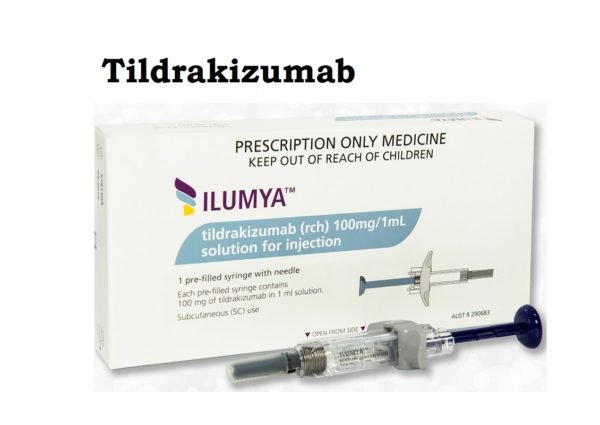Tildrakizumab (Ilumya) is a humanized monoclonal antibody that inhibits Interleukin 23 (IL-23) resulting in the inhibition of pro-inflammatory cytokines and chemokines.
Tildrakizumab (Ilumya) Uses:
-
Plaque psoriasis:
- It is indicated for the treatment of adults with moderate to severe plaque psoriasis who are candidates for systemic therapy or phototherapy.
Tildrakizumab (Ilumya) dose in Adults
Tildrakizumab (Ilumya) dose in the treatment of Plaque Psoriasis:
- 100 mg SubQ at weeks 0, 4, and then every 12 weeks thereafter.
Tildrakizumab (Ilumya) use in children:
The safety and efficacy of the drug in children is not established.
Pregnancy Risk Category: B1
- It is a monoclonal humanized IgG antibody. It can cross the placental barriers, just like the endogenous IgG.
- It has not been proven to cause adverse fetal outcomes in a small number of pregnant women.
Use during breastfeeding:
- It is unknown if the drug will be excreted into breastmilk.
- Breastmilk can contain IgG.
- Manufacturers recommend that you weigh the benefits and risks of treatment for the mother and infant.
Dose in Kidney disease:
- It has not been studied in patients with liver disease.
- The manufacturer has not recommended any adjustments in the dose.
Dose in liver disease:
- It has not been studied in patients with liver disease.
- The manufacturer has not recommended any adjustments in the dose.
Common Side Effects of Tildrakizumab (Ilumya):
-
Infection:
- Infection
-
Respiratory:
- Upper respiratory tract infection
Less Common Side Effects of Tildrakizumab (Ilumya):
-
Gastrointestinal:
- Diarrhea
-
Immunologic:
- Antibody development
-
Local:
- Injection site reaction
-
Dermatologic:
- Urticaria
-
Hypersensitivity:
- Angioedema
-
Respiratory:
- Tuberculosis
Contraindications to Tildrakizumab (Ilumya):
Severe allergic reactions to any component of the drug or the drug itself
Warnings and precautions
-
Hypersensitivity
- After the injection, serious allergic reactions such as angioedema or anaphylaxis can occur.
- If a hypersensitivity reaction occurs, treatment must be stopped immediately and the appropriate therapy instituted.
-
Infections
- Use of abrasives increases the risk of infectionTildrakizumab (Ilumya).
- Patients with upper respiratory tract infections are most common.
- Patients with a history of chronic, recurring infections should weigh the risks and benefits before beginning treatment.
- Active infections should be treated immediately.
- If a patient develops signs or symptoms of infection, they should seek medical attention immediately.
- If you have a serious infection, or if the treatment is ineffective, you may need to stop taking the medication until the problem is resolved.
-
Tuberculosis
- All patients must be tested for latent tuberculosis before treatment can begin.
- Before receiving treatment, anyone with active or late-stage tuberculosis must be treated.
- Those patients with a history of Tuberculosis but without an adequate history of anti-TB treatment should also be considered for anti-TB treatment before Tildrakizumab therapy.
- Patients must be closely monitored for any signs or symptoms of active tuberculosis during treatment.
Tildrakizumab: Drug Interaction
|
Belimumab |
May enhance the immunosuppressive effect of Biologic Anti-Psoriasis Agents. |
|
InFLIXimab |
May enhance the immunosuppressive effect of Biologic Anti-Psoriasis Agents. |
|
Vaccines (Live) |
Tildrakizumab may enhance the adverse/toxic effect of Vaccines (Live). The risk for contracting an infection from the vaccine may be increased. Tildrakizumab may diminish the therapeutic effect of Vaccines (Live). |
Monitor:
- Monitor for the clinical features of infections including the reactivation of latent tuberculosis.
- Before initiating therapy, patients should be screened for latent tuberculosis.
How to administer Tildrakizumab (Ilumya)?
- It is administered as a SubQ injection into the thighs, upper arm, or abdomen.
- Administration into or within 5 cms around the navel should be avoided.
- Injection into scars, stretch marks, bruised, tender, indurated, and inflamed area or skin affected by psoriasis should also be avoided.
Mechanism of action of Tildrakizumab (Ilumya):
- It is a monoclonal human IgG1/k antibody that inhibits Interleukin 23 (IL-223) binding to its receptors.
- It selectively binds the p19 subunit IL-23, inhibiting its interaction.
- This results in the release chemokines as well as cytokines that are associated with activation of IL23 receptors.
MetabolismIt is converted into small peptides or amino acids, similar to endogenous IgG.
Bioavailability is73% to 88%
Half-life eliminationIt takes approximately 23 days
Time to get therepeak serum concentrationIt takes approximately 6 days. By week 16, the steady-state concentration is at its highest
International Brand Names of Tildrakizumab:
- limetri
- Ilumetri
- Ilumya
Tildrakizumab Brand Names in Pakistan:
No Brands Available in Pakistan.







